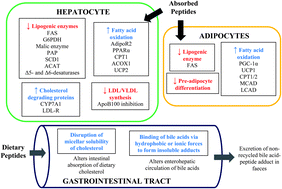Mechanisms and prospects of foodprotein hydrolysates and peptide-induced hypolipidaemia
Abstract
Hyperlipidaemia is an important risk factor for developing cardiovascular disease, a leading global health issue. While

* Corresponding authors
a
Health and Bio-products Research Laboratory, Department of Environmental Sciences, Faculty of Agriculture, Dalhousie University, Truro, Nova Scotia, Canada
E-mail:
cudenigwe@dal.ca
Fax: +1 9028931404
Tel: +1 9028936625
Hyperlipidaemia is an important risk factor for developing cardiovascular disease, a leading global health issue. While

 Please wait while we load your content...
Something went wrong. Try again?
Please wait while we load your content...
Something went wrong. Try again?
A. Howard and C. C. Udenigwe, Food Funct., 2013, 4, 40 DOI: 10.1039/C2FO30216K
To request permission to reproduce material from this article, please go to the Copyright Clearance Center request page.
If you are an author contributing to an RSC publication, you do not need to request permission provided correct acknowledgement is given.
If you are the author of this article, you do not need to request permission to reproduce figures and diagrams provided correct acknowledgement is given. If you want to reproduce the whole article in a third-party publication (excluding your thesis/dissertation for which permission is not required) please go to the Copyright Clearance Center request page.
Read more about how to correctly acknowledge RSC content.
 Fetching data from CrossRef.
Fetching data from CrossRef.
This may take some time to load.
Loading related content
